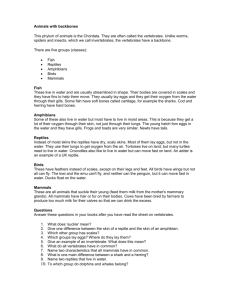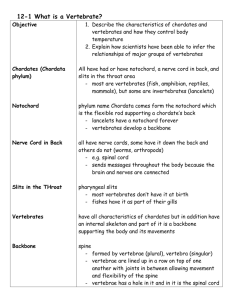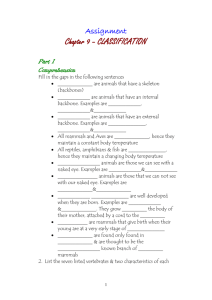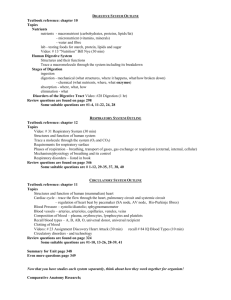RC 10
advertisement
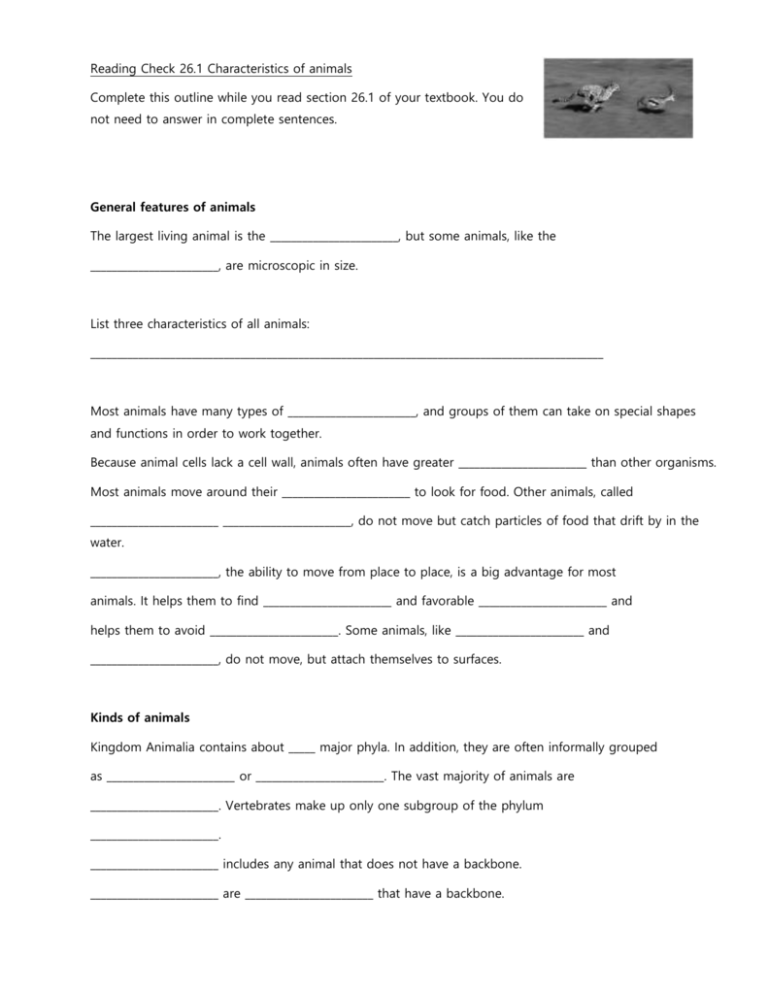
Reading Check 26.1 Characteristics of animals Complete this outline while you read section 26.1 of your textbook. You do not need to answer in complete sentences. General features of animals The largest living animal is the ________________________, but some animals, like the ________________________, are microscopic in size. List three characteristics of all animals: ________________________________________________________________________________________________ Most animals have many types of ________________________, and groups of them can take on special shapes and functions in order to work together. Because animal cells lack a cell wall, animals often have greater ________________________ than other organisms. Most animals move around their ________________________ to look for food. Other animals, called ________________________ ________________________, do not move but catch particles of food that drift by in the water. ________________________, the ability to move from place to place, is a big advantage for most animals. It helps them to find ________________________ and favorable ________________________ and helps them to avoid ________________________. Some animals, like ________________________ and ________________________, do not move, but attach themselves to surfaces. Kinds of animals Kingdom Animalia contains about _____ major phyla. In addition, they are often informally grouped as ________________________ or ________________________. The vast majority of animals are ________________________. Vertebrates make up only one subgroup of the phylum ________________________. ________________________ includes any animal that does not have a backbone. ________________________ are ________________________ that have a backbone. ________________________ are the individual segments that make up the backbone. The backbone supports and protects a dorsal ________________________ ________________________ and provides a site for ________________________ attachment. This complex ________________________ allowed some vertebrates to grow much larger than their invertebrate ancestors. In the space below, briefly describe the significance of the image above. How does it relate to this section of the textbook? Reading Check 26.2 Animal body systems Complete this outline while you read section 26.2 of your textbook. You do not need to answer in complete sentences. Support An animal’s ________________________ provides a framework that supports its body. This structure is also vital to an animal’s ________________________. Define each type of skeleton AND list one organism that has it Hydrostatic skeleton ________________________________________________________________________ Exoskeleton ________________________________________________________________________ Endoskeleton ________________________________________________________________________ Digestive and excretory systems The digestive system is responsible for extracting ______________________ and ______________________ from an animal’s food. Sponges, which are animals that lack a digestive system, digest their food within their body ________________________. All other animas digest their food outside their cells within a digestive ________________________. Simple animals have a ________________________ cavity with only one opening, where ________________________ goes in and ________________________ go out. More complex animals have a one-way digestive ________________________, or gut, where food moves from the ________________________ to the ________________________. ________________________ is the removal of waste products like ________________________, which can be harmful if they are not removed. Organisms that live in the water excrete ________________________ into the water. Animals that live on land, though, need to minimize ________________________ loss, and so they convert ammonia to less ________________________ chemicals before passing them out of the body. This way, ________________________ and other useful substances can be returned to the body without being excreted. Nervous system The nervous system carries information about the ________________________ through the body and coordinates ________________________ and ________________________. Nerve cells carry messages in the form of ________________________ impulses. A simple arrangement of nerve cells is called a ________________________ net, and the nerve cells do not coordinate actions directly. More complex clusters of nerve cells, called ______________________, can coordinate responses. Complex invertebrates and vertebrates have true ________________________ with sensory structures associated with them. continued on next page Respiratory and circulatory systems The respiratory system exchanges ________________________ and carbon dioxide between the body and the environment. Many aquatic animals respire using ________________________, while terrestrial animals can respire using a variety of respiratory organs, including ________________________. The circulatory system transports ________________________ and ________________________, along with other substances, within the body. Some small animals do not require a circulatory system because their ________________________ can obtain these necessities directly. Larger animals have ________________________ located far from the sources, and so they must transport nutrients and wastes to and from these cells. In an open circulatory system, a heart pumps fluid containing oxygen and nutrients into the body ________________________. From there, the fluid washes across the body’s ________________________. In a closed circulatory system, a heart pumps blood through a system of blood ___________________. Reproduction Asexual reproduction occurs when an individual produces ________________________ copies of itself and does not mix its ________________________ with those of another. Sexual reproduction occurs with the union of a male and a female ________________________. These special haploid cells are produced in the sex ________________________. The ________________________ produce sperm, and the ________________________ produce eggs. In the space below, briefly describe the significance of the image on the previous page. How does it relate to this section of the textbook? Reading Check 26.3 Evolutionary trends in animals Complete this outline while you read section 26.3 of your textbook, omitting pages 634-635. You do not need to answer in complete sentences. Scientists believe that animals first appeared in the _______________________ about _____ million years ago. Tissues and symmetry The cells of all animals except _______________________ are organized into units called _______________________. In some simple animals, tissues are not arranged into ____________________. Body _______________________ refers to how an animal’s body can be divided into similar pieces. Sponges are _______________________. Animals with _______________________ symmetry have body parts arranged around a central axis, while animals whose bodies can be divided into mirror-image halves show _______________________ symmetry. Most bilaterally symmetrical animals show _______________________, or a concentration of sensory structures and nerves toward the fronts of their bodies. Body cavities Animals with bilateral symmetry can be classified according to whether or not they have a fluidfilled space between the body wall and gut. This body cavity is also called a ______________________. In an _______________________, there is no body cavity. A false coelom, or __________________________, is filled with a liquid that provides support. _______________________ have a true coelom, which holds the _______________________ and other internal _______________________. The coelom cushions protects internal organs from the moving surrounding ______________________. Segmentation and jointed appendages Similar repeating units in an animal’s body are called _______________________. Segmentation allows for greater _______________________ and evolutionary _______________________. Jointed appendages were first seen in _______________________. Joints permit powerful _______________________ and help in _______________________. In the space below, briefly describe the significance of the image above. How does it relate to this section of the textbook? Reading Check 26.4 Chordate evolution Complete this outline while you read 26.4 of your textbook. You do not need to answer in complete sentences. Characteristics of chordates List and describe the four characteristics of all chordates __________________________________________________________________________________________________ __________________________________________________________________________________________________ __________________________________________________________________________________________________ __________________________________________________________________________________________________ Most chordate species belong to the subphylum _______________________, but there are two other subphyla in phylum Chordata that do not have a _______________________, and thus are called _______________________ _______________________. These two types are _______________________ and _______________________. The first two traits that allowed fish to become efficient underwater predators were _______________________ and paired _______________________. The first vertebrates to emerge on land had _______________________ fins that functioned like primitive _______________________ and allowed them to move in shallow water. These fishes would have spent most of their time in the water, and probably represent a _______________________ between animals that lived only in water and the first vertebrates to live mostly on land, the _______________________. Amphibians became better adapted to life on land thanks to _______________________ that could exchange gases outside of water, a more efficient _______________________ that delivered more oxygen to the body than a fish’s, and strong _______________________ that supported their bodies and movement. Reptiles were even better suited to life on land than amphibians. They developed _______________________, scale-covered skin and the _______________________ egg. This egg meant that reptiles were not dependent on _______________________ for reproduction. Today, reptiles, _______________________ and _______________________ have these kinds of eggs. One important group of reptiles, the _______________________, dominated life on land for more than 100 million years before going extinct at the end of the _______________________ Period. _______________________ evolved about 150 million years ago from small dinosaurs. Early mammals, which first appeared about ____ million years ago, were the size of _______________. The _______________________ of dinosaurs opened a huge opportunity for the evolution of mammals. Although mammals tend to be dominant species today, there were even more, larger mammals that went extinct following the last _______________________ age, about 2 million to 10,000 years ago.

